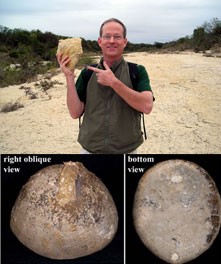During the Age of Dinosaurs, Mississippi was largely submerged beneath a shallow arm of the Gulf of Mexico extending up the Mississippi River Valley to the southern tip of Illinois. This extension of the Gulf, or bay, is called the Mississippi Embayment. Dinosaur remains are occasionally found in northeast Mississippi, where deposits of that age are not completely covered due to subsequent flooding of the Mississippi Embayment. Although dinosaurs never inhabited the ocean, carcasses frequently drifted out to sea due to storms and ocean-bound river flow. As the carcasses floated along due to the gases produced in their bloating gut, sharks and other sea creatures fed on them, slowly disarticulating the skeleton. This is one of the reasons why dinosaur bones in marine deposits are typically found individually (and not as complete skeletons) with bite marks all over them. A fossil collector from Columbus, Mississippi, donated to the Museum a juvenile hadrosaur (duck-billed dinosaur) upper arm bone with the tips of three shark teeth embedded in it! The serrated teeth belonged to the scavenging shark Squalicorax-the extinct crow shark and Cretaceous equivalent of the tiger shark (Galeocerdo). Other species of dinosaurs from Columbus and Amory include the armored nodosaurs, "bird mimic" ornithomimids, and at least two carnivorous species, including large theropods, like Appalachiosaurus, and the smaller raptors, like Saurornitholestes.

